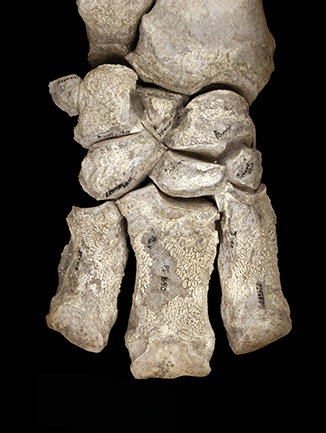Ashfall Fossil Beds is a working research site that is unique and invaluable to science.
What clues did researchers discover that provided a window into what happened at the fossil site so long ago?
It is apparent that the birds died very shortly after the ash dust began to fall from the sky since the bird skeletons are located in the lowest (basal) layers of the ashbed. As the ash accumulated on the sandy terrain, it may have taken only hours for the cranes, hawks and vultures to die. But the story seems quite different for the larger mammals. Many bones of the camels, horses, and rhinos have patches of rough, frothy bone growth on the surface of the normal bone. The pattern of accumulation of abnormal bone is associated with lung damage first described by French pathologist Pierre Marie and his colleague Eugen von Bamberger in 1890. Also known as Marie’s Disease, or Bamberger-Marie Disease, the currently accepted technical term for the malady is hypertrophic osteopathy. It has been documented in humans and a variety of domesticated species. The abnormal bone growth is the secondary result of various organ diseases, but occurs frequently with lung-damaging diseases including tuberculosis and pneumonia, as well as tumors and abscesses. Symptoms begin with soft tissue swelling of the feet, fever, cough, and lameness. Left untreated, the thick pathologic bone growth develops on the limb bones and may spread to other parts of the skeleton.
There was no place for the local wildlife to escape the dense clouds of volcanic ash, or the inevitable inhalation of dangerous amounts of the ash when the camels, horses and rhinos were grazing—or attempting to graze on the glass-dust covered landscape. The rhinos lived longer than the smaller-sized species such as the horses and camels, and the animals lingered for weeks before succumbing to the effects of the volcanic ash.
edited option below...
Development as a Research and Public Site
Following its initial discovery in 1971 by Michael Voorhies, a paleontologist from the University of Nebraska–Lincoln, the Ashfall Fossil Beds quickly gained recognition as a site of global paleontological importance. The University of Nebraska State Museum, under Dr. Voorhies’ guidance, began extensive excavation efforts, establishing a dedicated research and exhibition facility. To protect the delicate fossils from weathering and to allow for in-situ public viewing, the “Fossil Rhino Barn” was constructed over a portion of the main excavation site. This innovative approach allows visitors to observe paleontologists at work and see freshly exposed fossils as they are unearthed, providing a unique educational experience that bridges scientific research with public engagement.
Geological Significance
The geological context of Ashfall is what makes it truly exceptional. The fossils are preserved within a layer of volcanic ash originating from a supervolcano eruption in present-day Idaho (the Bruneau-Jarbidge caldera). This ash was carried by prevailing winds and deposited over a large area, including what is now northeastern Nebraska. Critically, the ash settled into a shallow watering hole, entombing hundreds of animals that had gathered there. The fine-grained ash, combined with groundwater, created an alkaline environment that rapidly fossilized the skeletons, preserving them in exquisite detail, often in their natural articulation. This rapid burial also explains the remarkable three-dimensional preservation, unlike many compressed fossils found in sedimentary rocks.
The Miocene Ecosystem Revealed
The Ashfall Fossil Beds provide an unparalleled window into the late Miocene epoch ecosystem of North America. The site is famous for its remarkably preserved skeletons of large mammals, including rhinos, three-toed horses, camels, and saber-toothed deer. These animals died from inhaling the fine volcanic ash, which caused their lungs to fill, leading to suffocation. The sheer number and variety of species found, along with their preserved postures (some indicating their final struggles), offer invaluable insights into the behavior, diet, and interactions of these ancient creatures. The presence of juvenile animals and pregnant females further enriches our understanding of the population structure and life cycles of these Miocene mammals.
Ongoing Research and Legacy
Today, the Ashfall Fossil Beds State Historical Park continues to be an active research site and a popular tourist destination. Paleontologists still conduct excavations, with new discoveries periodically adding to the already vast collection of Miocene fossils. The site’s continued contribution to paleontology extends beyond just the large mammals, with studies also focusing on smaller vertebrates, plant remains, and the precise dating of the ash layers. The legacy of Ashfall lies not only in its extraordinary fossil preservation but also in its ongoing role as a living laboratory that continues to reshape our understanding of ancient North American ecosystems and the dramatic impact of geological events on life.

Rhino foot bones from the volcanic ashbed. Note the whitish, bumpy bone growth on the toe bones. This is the abnormal, pathologic bone growth that appears to be associated with extensive lung damage from hypertrophic osteopathy.

